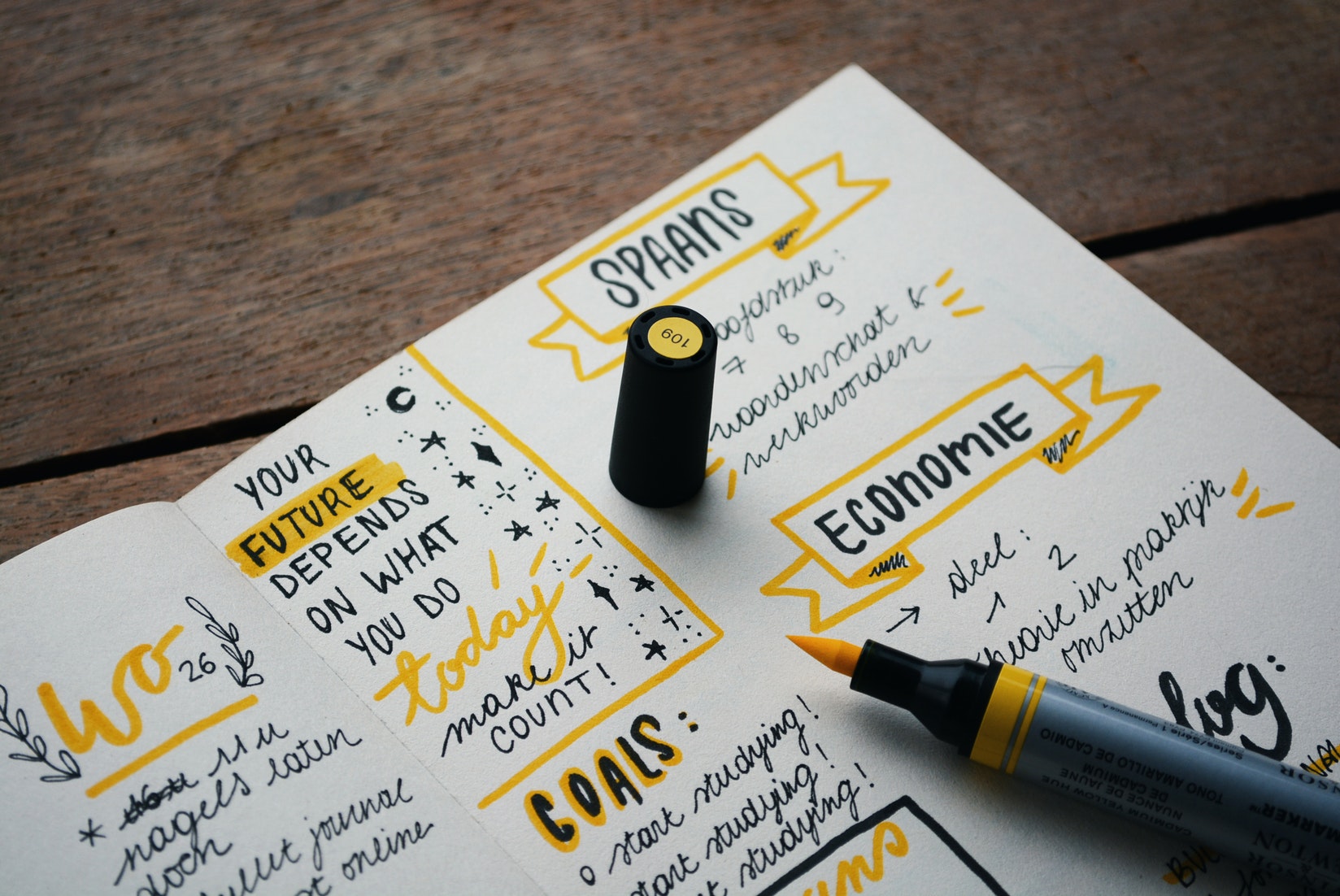Why is it that we start the year filled with renewed drive and motivation only to find ourselves drifting aimlessly through life a few months later?
It’s easy to make plans for the future and how we’re going to change our life for the better — it’s much more difficult to build new habits and overcome adversity on the road to success.
But it doesn’t have to be that way.
Start by setting a direction
Most of us have made this mistake in the past — setting a goal that focuses entirely on a destination, not the journey. “I want a bikini body.” “I want to buy a house.” “I want a million dollars in my savings account.”

While setting a destination goal is better than nothing, it’s not ideal. We tend to fixate on the desired result and completely ignore the hardships and challenges on the way to reaching that goal. This means we are much more prone to abandoning our goals after the first few hiccups. Plus, people often pursue goals that leave them feeling miserable and deflated because they think too much about what they could have and very little about what achieving their goal will cost.
If we don’t take the journey into consideration and get in the right mental state, we end up standing in the way of our own success. So what can we do about that?
The answer lies in setting a life direction instead of sticking to individual goals. And the best way to figure out what that direction should be is to look inward and figure out what energizes you and brings you joy and fulfillment.
You can start by asking yourself a few simple questions:
- When am I happiest? When does the time fly by?
- What daily activities do I look forward to?
- What do I want to learn next?
- Who do I want to connect with? What kind of people inspire me to be better and strive for more?
When you know the answers to these questions, the next step is to set goals that put you on a journey you know you will enjoy.
In fact, as soon as you start moving in the right direction, the goal itself becomes less of a focus and more of a reinforcement of the journey and the decisions you’re making along the way.
There’s no better way to achieve what you set out to do than to enjoy every minute of doing it. So stop hopping from one small goal to another and focus on steering your life in the right direction.
Make a detailed action plan
If you’re shooting for the stars, the whole thing may seem like mission impossible. It’s no secret that the more ambitious the goal, the more detailed and meticulous an action plan you’ll need. But that’s an issue that can be easily solved if you put your mind to it.
As with any large-scale project, you need to start by determining the key steps to achieving your goal. Say you’re building a house. You will need to buy the land and find the right architect, negotiate with suppliers and source your favorite bathroom tiles from Italy, and everything in between. It’s time-consuming and requires constant input.
Any serious life goal will be just as (if not more) challenging to pull off. That’s why you need to figure out the critical parts of the plan, then break them down into smaller, more achievable tasks and actions.
The point of doing that is to reward yourself with the pleasure of completing tasks and the immense feelings of relief and satisfaction that come with making progress. It’s so much easier to stay focused and motivated when you’re moving closer to your goal — even if you’re just taking baby steps.
Schedule time with yourself to assess your progress
We must make the time to check in with ourselves and reflect on our thoughts, feelings, and experiences.
As physicist, essayist, and novelist Alan Lightman wrote in his recent article on Ideas TED, “We are losing our ability to know who we are and what is important to us. We are creating a global machine in which each of us is a mindless and reflexive cog, relentlessly driven by the speed, noise, and artificial urgency of the wired world.”

Not only do we need to keep assessing our progress toward the goal, but we must also listen to our inner voice to make sure we still want to pursue this goal and are doing it for the right reasons. It’s absolutely fine to tweak or even completely abandon a goal if it isn’t working. We need to drive goals and shape our life journey, not the other way around.
Embrace proven strategies
Research shows that people are two to three times more likely to achieve their goals if they make very specific plans about when, where, and how they are going to perform certain tasks. This technique is called implementation intention and is deeply rooted in human psychology. Many different studies have proved its effectiveness at making people more accountable for the promises they make to themselves. All you need to do is fill in the blanks in the following sentence:
“Next week, I will spend at least 10 minutes [taking action/performing activity] on [day] at [time of day] at/in [place].”
Another neat way to use this research is to experiment with a strategy known as habit stacking. This strategy is based on the idea of a connected brain. The human brain builds a very strong network of neurons based on our daily actions and routines — that’s how we develop habits. The more often we undertake a task, the stronger and more efficient the connections become. The most basic habits and routines are so deeply ingrained in the brain that they become reflexes. For instance, we take shower in the morning, say thank you after a meal, or open the blinds when the sun rises without having to think about it.
So when we need to build a new habit, the easiest way to make it stick is to capitalize on the network of associations. Identify a strong habit that you have and attach the new one to it. This is a form of intention implementation, but you focus on pairing the new habit with an old one rather than associating with a particular time and day. How does this look when applied to everyday life? Here are a few examples:
- After I switch off my alarm in the morning, I will drink a glass of lemon water.
- After pouring myself a cup of coffee in the morning, I will write down my day’s goals.
- After closing my laptop at the end of the work day, I will immediately change into my gym clothes.
- After I sit down to have dinner with my family, I will share one interesting thing I’ve learned today.
- After getting into bed at night, I will read 10 pages of a book.
Align your environment with your goals
You may think that your motivation and willpower are the key factors that determine whether you’ll reach your goals or not. But the science shows that the influences that surround us when we’re trying to make a long-lasting behavioral change have, in fact, a much greater impact on our ability to succeed. This is called the choice of architecture, and what it really refers to is our tendency to choose what’s easy over what’s good.

Whether in our professional or personal lives, we often make decisions based on what’s available now, choosing from the options around us. For instance, you are much more likely to have a beer every night if you keep the fridge stocked with your favorite brew. And you’re much more likely to waste your evening watching a pointless show if you turn the TV on as soon as you get home.
But when it comes to building new habits, the choice of architecture can also make a positive impact. Say, for example, you are trying to spend less time on your phone and more time reading — simply carrying a book or a magazine with you will help you shape a new habit.
Aligning your environment with your goals is extremely important and will nudge you in the right direction even when your willpower wanes.
The Goldilocks Rule and other secrets to staying motivated
Why do some people go on to build habits that make them exceptionally good at what they practice, while most of us struggle to keep motivated and fail repeatedly as a result?
Scientists have been hard at work trying to answer this question. And one of the most significant things they have found is that staying motivated throughout the journey is a matter of working on tasks that are just on the edge of our current abilities — not too ambitious or difficult but not too easy either, just enough to keep us invested in the challenge. This strategy has become known as the Goldilocks Rule (a nod to the popular fairytale of “Goldilocks and the Three Bears”) and remains one of the most effective ways to maintain interest and effort in the face of difficulties.
If you manage to maintain optimal levels of motivation throughout the journey, you will start to make significant progress — and that’s the other piece of the motivation puzzle. Constantly measuring your progress and tracking your performance is an incredibly powerful and effective way to stay pumped. When you receive positive feedback and see yourself making progress, the rush of satisfaction refills your energy reservoirs and pushes you forward. That’s why so many companies employ gamification — reaching and unlocking a new level boosts your self-esteem and drives you forward.
Bringing it all together
If you’re serious about making positive changes in your life, you need to get serious about setting goals and keeping close tabs on your progress. If there’s anything you take away from this article, let it be the following:
- Your goals should lead you toward the life you want. Focus on the journey, not the destination.
- Don’t leave your success to chance — break your big goals into smaller tasks that are easy to achieve and make you feel good about inching closer to the goal.
- Keep checking in with yourself as you progress; it’s OK to change your goals if they don’t give you the satisfaction you expected.
- Practice habit stacking.
- Make sure you surround yourself with positive cues and minimize distractions in your environment.
- Don’t aim too high — you can only achieve peak performance when your goals are at the right degree of difficulty.
Now go and make it happen!








































































Send Comment: